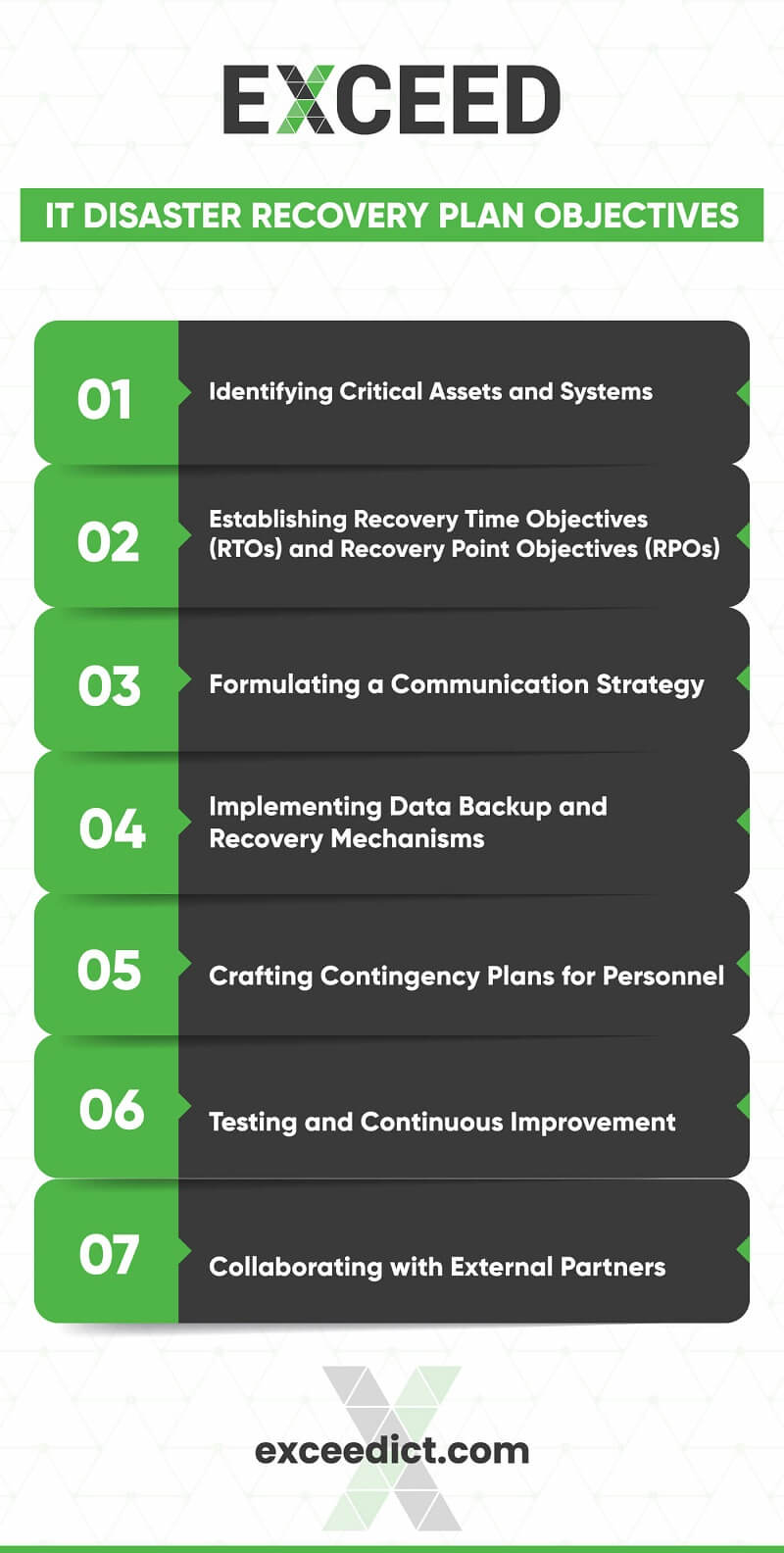
IT Disaster Recovery Plan Objectives to Safeguard Business
 In today’s digital age, where businesses heavily rely on technology for their day-to-day operations, the significance of IT disaster recovery plans cannot be overstated. These comprehensive strategies play a pivotal role in safeguarding business continuity when unforeseen disruptions strike. In this article, we delve into the key IT disaster recovery plan objectives that form the bedrock of a resilient and responsive approach to managing IT-related crises.
In today’s digital age, where businesses heavily rely on technology for their day-to-day operations, the significance of IT disaster recovery plans cannot be overstated. These comprehensive strategies play a pivotal role in safeguarding business continuity when unforeseen disruptions strike. In this article, we delve into the key IT disaster recovery plan objectives that form the bedrock of a resilient and responsive approach to managing IT-related crises.
An effective IT disaster recovery plan aims to mitigate potential downtime, data loss, and financial impacts caused by disruptions such as cyberattacks, natural disasters, or hardware failures.
IT Disaster Recovery Plan Objectives

Here, we explore the critical objectives that guide the development and implementation of a robust recovery strategy.
>> Identifying Critical Assets and Systems
A cornerstone of any successful disaster recovery plan is the identification of critical IT assets and systems. These assets can include servers, databases, applications, and communication tools. By prioritising these components, businesses can allocate resources efficiently, ensuring swift recovery and minimising productivity loss.
>> Establishing Recovery Time Objectives (RTOs) and Recovery Point Objectives (RPOs)
RTOs and RPOs are vital metrics that define the acceptable downtime and data loss thresholds during a disruption. RTO specifies the maximum time a system can remain down before it affects business operations, while RPO indicates the maximum data loss allowed. Striking the right balance between these objectives is crucial in tailoring the recovery plan to the business’s unique needs.
>> Formulating a Communication Strategy
Clear and effective communication is pivotal during a crisis. Establishing a comprehensive communication strategy ensures that all stakeholders, including employees, customers, and partners, are promptly informed about the situation, recovery progress, and potential impacts. Open lines of communication foster trust and transparency, which are essential for maintaining reputation and customer loyalty.
>> Implementing Data Backup and Recovery Mechanisms
Data is the lifeblood of modern businesses, making data backup and recovery paramount. Robust backup mechanisms, both on-site and off-site, should be in place to ensure data integrity and availability. Regular testing of these mechanisms guarantees that data can be recovered accurately and efficiently when needed.
>> Crafting Contingency Plans for Personnel
Amidst a crisis, personnel continuity is vital. Developing contingency plans for key personnel roles guarantees a seamless transition of responsibilities during disruptions. Cross-training and role-specific guidelines empower employees to maintain essential operations, minimising the impact of workforce shortages.
>> Testing and Continuous Improvement
An IT disaster recovery plan is only as effective as its testing and continuous improvement processes. Regular drills and simulations of various disaster scenarios allow businesses to identify gaps and weaknesses in their strategies. Adapting the plan based on these insights enhances its responsiveness and adaptability.
>> Collaborating with External Partners
Collaboration with external partners, such as cloud service providers, vendors, and third-party recovery experts, can provide additional resources and expertise during recovery efforts. Integrating these partnerships into the recovery plan expands the organisation’s capabilities and accelerates the restoration process.
Frequently Asked Questions (FAQs)
 Q: What is the primary goal of an IT disaster recovery plan?
Q: What is the primary goal of an IT disaster recovery plan?
A: The primary goal of an IT disaster recovery plan is to ensure business continuity by minimising downtime, data loss, and financial impacts during disruptions.
Q: Why are RTOs and RPOs important?
A: Recovery Time Objectives (RTOs) and Recovery Point Objectives (RPOs) define acceptable downtime and data loss thresholds, aiding in tailoring the recovery plan to specific business needs.
Q: How often should an IT disaster recovery plan be tested?
A: An IT disaster recovery plan should be tested regularly through drills and simulations to identify weaknesses and enhance responsiveness.
Q: Can external partners enhance disaster recovery efforts?
A: Yes, collaborating with external partners, such as cloud service providers and recovery experts, can provide additional resources and expertise.
Q: What is the role of a communication strategy in disaster recovery?
A: A communication strategy ensures clear and timely information dissemination to stakeholders, fostering trust and transparency during crises.
Q: How does cross-training personnel contribute to recovery?
A: Cross-training enables employees to assume essential roles during disruptions, minimising the impact of workforce shortages.
In a world where technology underpins every facet of business operations, having a well-crafted IT disaster recovery plan is non-negotiable. By focusing on critical objectives such as identifying assets, setting recovery benchmarks, and fostering collaboration, organisations can bolster their resilience against unforeseen disruptions.
Remember, a proactive approach to disaster recovery not only safeguards business continuity but also demonstrates a commitment to the reliability and security of your operations.
You may also like to know more about
- Disaster Recovery Plan For Ensuring Business Continuity in Challenging Times.
- Business Continuity Planning vs Disaster Recovery Planning.
- Step by Step Guide for a business continuity plan.
- What is Business Continuity Planning? Importance, Risk Assessment, & Core Objectives.
- Understanding the Disaster Recovery Planning – steps, benefits and best practices.
- Disaster Recovery Planning To Ensure The Connectivity in Crisis.
Stay connected with EXCEED ICT
Stay connected with EXCEED ICT by joining our social networks (given at footer). Get the latest updates, news, and tips for enterprise device deployment. Follow us on Twitter, Facebook, and LinkedIn for the best enterprise device deployment solutions.
Help us to improve our enterprise by rating us on Google Maps. Your feedback and comments are valuable to us and will be used to make our services even better.



